4DSOUND: A Retrospective (2015)
Paul Oomen
Initially written for the retrospective sound exhibition premiered at the opening of the Spatial Sound Institute in October 2015, 4DSOUND Founder Paul Oomen looks back over some key developments in this emerging spatial sound practice.

Early experiments with speaker configuration and listening, 2011
When 4DSOUND started, it was neither a sound system, nor a technology. At first it was a musical vision, a desire to make the often hidden energetic movements within sound perceivable, something that felt like unleashing sound’s true potential. Central in my vision was to enable a listening experience that would feel more ‘real’, that would incorporate the physical presence of the listener and the reality of the space sound exists in, and is a part of.
Spatiality of sound is among the finest and most subtle levels of information we are able to perceive. Both powerful and vulnerable, we can be completely immersed in it, it can evoke entire new worlds – if we are only able to listen. After eight years of developing the technology and exploring its expressive possibilities, it has become clear that the development of the listener itself, the evolution of our cognitive capacities, is an integral part of the technology.
Spatial sound is a medium that can open the gate to our consciousness, encouraging heightened awareness of environment, a deeper sense of the connection between mind and body, empathic sensitivity and more nuanced social interaction with those around us. It challenges us to listen to the world in a more engaging way, offering us a chance to become more sensitive human beings.
During the past four years, a range of artistic collaborations in the field of music, art and immersive technologies has shown evidence of the often fascinating, surprising, sometimes disruptive or even hilarious findings that come with the emergence of what I believe is a truly new medium, which we are only on the verge of starting to understand.
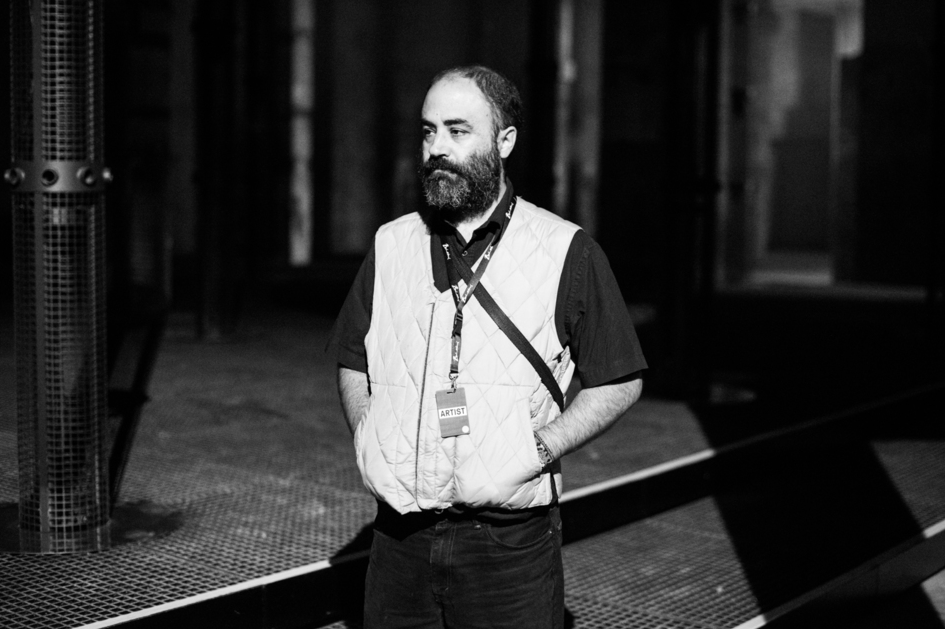 Murcof at Berlin Atonal. Image: Camille Blake
Murcof at Berlin Atonal. Image: Camille BlakeOne of the first musicians I spoke with about 4DSOUND was Mexican composer Fernando Corona, a.k.a. Murcof. Deeply influenced by his vast sounding landscapes that evoke a melancholic spatial poetry, I went to visit Corona in Barcelona in 2009 to explain my ideas to him. Leaning against the bar of a noisy tea-house, desperately looking for a place to power my laptop, I was able to show him a preliminary version of our software visualising how sounds can move in space. Five years later, Corona was among the first participants of our Artist Residency series in 4DSOUND’s former studio in Amsterdam. He created a series of five compositions exploring his highly personal ways of structure and narrative in music, by means of space.
'I wasted almost two days trying to adapt one of my existing pieces to the system only to discard it completely and restart from scratch. The system really demands to be heard before writing down any ideas for it, and it also pushes you to change your approach to the whole composition process.'
— Murcof in conversation with Resident Advisor, July 2014
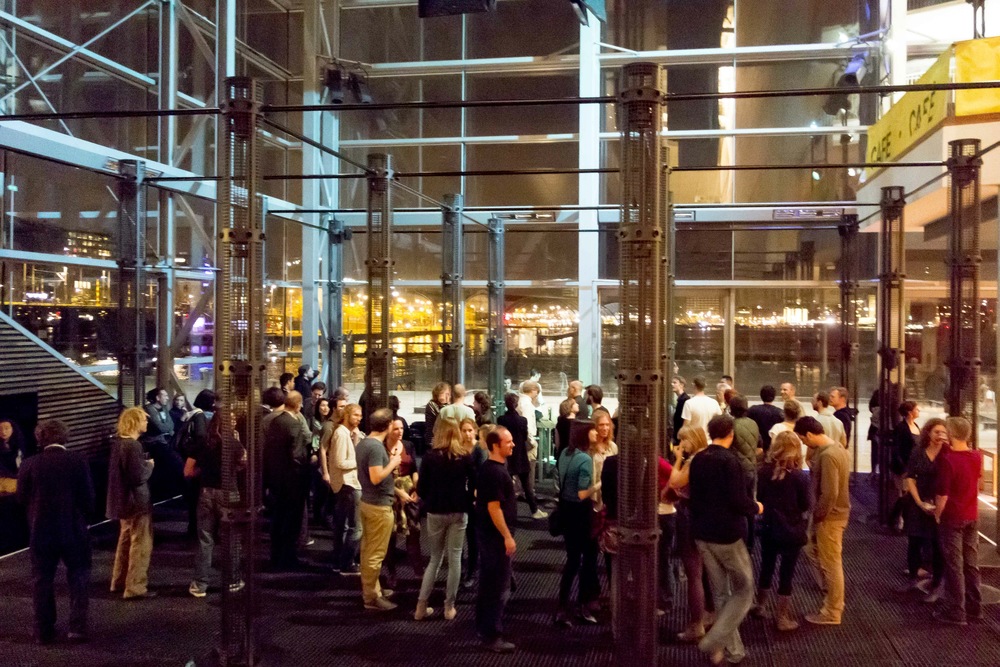 4DSOUND at Amsterdam Dance Event 2012 with Marco Ciciliani
4DSOUND at Amsterdam Dance Event 2012 with Marco CicilianiImage: Henri Blommers
The work K by experimental composer Marco Ciciliani opened the first public showcase of the technology at Amsterdam Dance Event, October 2012. The work at first consists of a superimposition of all tracks from Kraftwerk’s emblematic electronic music album ‘Radio Activity’, forming a diffuse architecture of sound, then each track is turned inside-out as a static spectral sound image, creating shifting walls of noise through the space of different colorations.
 Long-standing 4DSOUND collaborator Max Cooper
Long-standing 4DSOUND collaborator Max CooperOne of 4DSOUND’s early adopters has been Max Cooper, an artist regularly associated with the project since the premiere of his 4DSOUND live show in August 2013. His spatial sound show received strong acclaim from international audiences and press, evoking an experience that was considered completely new in the context of club music.
'The music danced around us instead of us dancing on it …many people sat down on the ground with their eyes closed, the performance became almost meditation …when the performance was finally finished, the crowd shook awake as from a dream, not fully believing of what they had just experienced.'
- DJ Mag, October 2014
With his background as a scientist in the field of computational biology, Cooper also has a feel for a didactic, analytic approach which is centre stage in his six sound sculptures created for 4DSOUND. In a humorous, abrasive or thought-provoking way, each of the sculptures is designed to convey particular spatial perceptions, such as having moments with single sounds to demonstrate clear paths, implosions and explosions, positions and other spatial effects.
'I had to imagine, how would I want to hear each piece of music under the assumption that it is a living physical entity that exists in real space and time. It takes away some of the abstraction of the emotive and subconscious response to music that I usually use to drive my creative process, and turns the music into something much more real in an everyday sense – it has to be something that you can walk inside, explore and discover new things within.'
- Max Cooper in A Magazine, March 2014
Besides a strong focus on electronic music, another important aspect of our musical exploration has been translating the world of acoustical instruments to the 4DSOUND system. A variety of approaches has emerged, from truthful simulation of real acoustical situations, to spatially extending a live acoustic music concert, to using acoustical instrument as source material for heavily processed spatial sound art.
 4DSOUND and The Rotterdam Philharmonic Orchestra at Blown Away in 2013
4DSOUND and The Rotterdam Philharmonic Orchestra at Blown Away in 2013 In 2013, I collaborated with the Rotterdam Philharmonic Orchestra on a series of spatial interpretations of orchestral works from the classical-romantic repertoire. The aim was to create an experience that would engage listeners with the orchestra in various new ways – by extending the experience of classical compositions with a spatial listening dimension, creating musical encounters between the orchestra and electronic musicians, and processing the sound palette of the orchestra into generative spatial sound sculptures. The work Pathetique uses the rich sound world from Tchaikovsky’s 6th Symphony and transforms it into an organically evolving sound landscape.
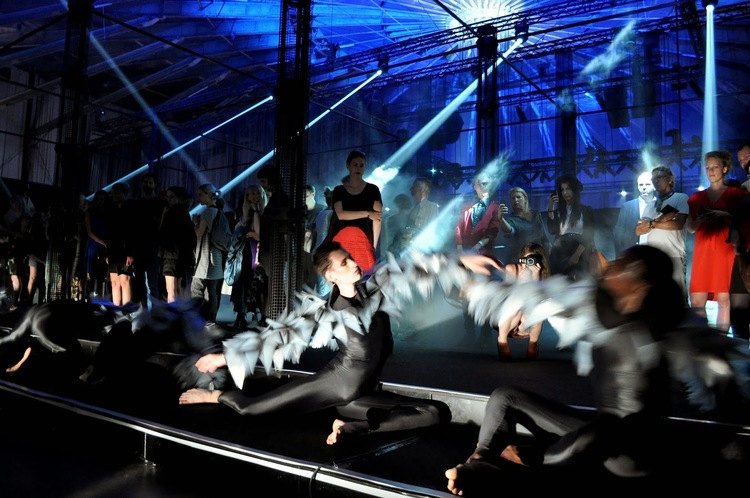
Zero by Nanine Linning, a choreographed A/V performance with costumes by Iris van Herpen
For the Opening of the International Fashion Week 2014, sound designer and 4DSOUND’s creative developer Salvador Breed collaborated with choreographer Nanine Linning and haute couture designer Iris van Herpen on an interdisciplinary performance of Linning’s work ZERO. Dancers moved through the audience, wearing Van Herpen’s distinctly designed costumes, interacting with physical shapes of sound that emerge in space. Shadows of music by Joseph Haydn, Arvo Pärt and Philip Glass hover in between the audience like phantoms, creating an intense and hypnotic experience.
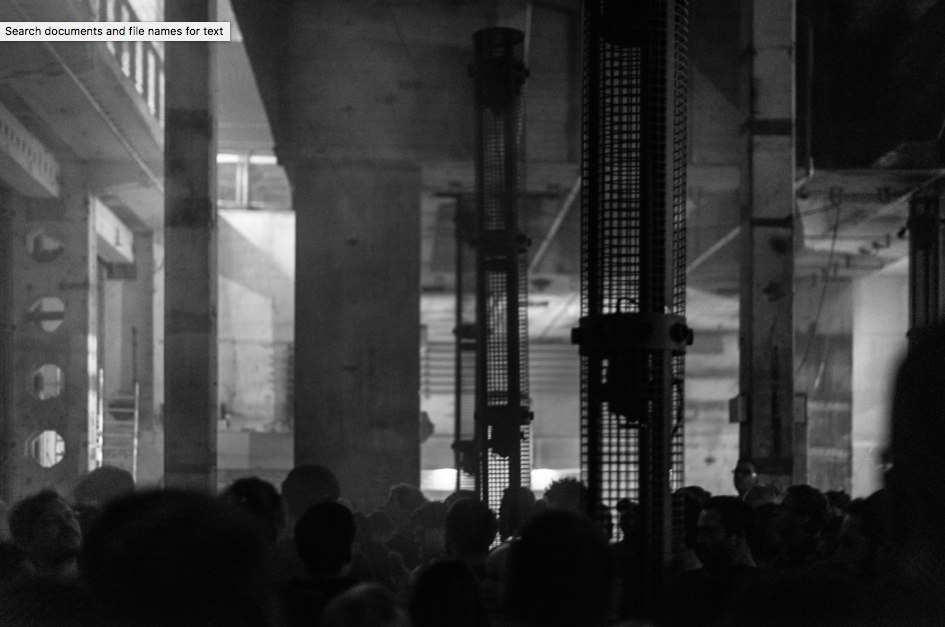 Berlin Atonal. Image: Camille Blake
Berlin Atonal. Image: Camille BlakeFor Berlin Atonal Festival 2014, French composer and sound designer Thomas Vaquié was commissioned to create a site-specific work for 4DSOUND in the immense space of Kraftwerk Berlin, one of the city’s former power plants. Vaquié’s creation derives entirely from cut fragments of string instruments, found in a variety of contemporary classical compositions for ensemble. He abstractly investigates the properties of the sound’s materiality by exploring spatial attributes such as position, distance, angle, diffusion, and movement.
My close collaboration with John Connell, at present 4DSOUND’s Creative Director, visual artist Florence To and voice and movement teacher Robert Jan Liethoff, is rooted in our shared interest in the connection between sound and consciousness. In February 2014, I hosted the artists at the 4DSOUND studio to develop first experiments using guided meditation and sound to create an immersive listening experience.
In June 2014, I revisited the ideas with Connell and To, but contingent to circumstance, the work in the studio had to take place during the nightly hours this time. While we tried hard to keep ourselves awake throughout the night, we discovered a different and highly imaginative form of spatial listening, which specifically revealed itself during this transitional state between sleeping and waking. While the mind is drifting in and out of its conscious state, the responses to sensory stimuli in the surrounding environment become enlarged, unpredictable and strongly intuitive, inducing experiences of lucid dreaming and hallucination.
Drifting in the hypnagogic state in NOQTURNL, part of the Circadian programme at TodaysArt.
As part of the 4DSOUND: Circadian programme at TodaysArt Festival, September 2015, Connell and To premiered their work NOQTURNL, an overnight audiovisual performance exploring collective dreamstate. Through patterns and structures of light and shifting soundscapes working with tones, field recordings and voice, participants are encouraged to explore their individual dream experiences, stimulating self-reflection, processing of memories, perceived mental and physical blockages and, ultimately, a dialogue with non-ordinary states of awareness and self-awareness at a deeper level.
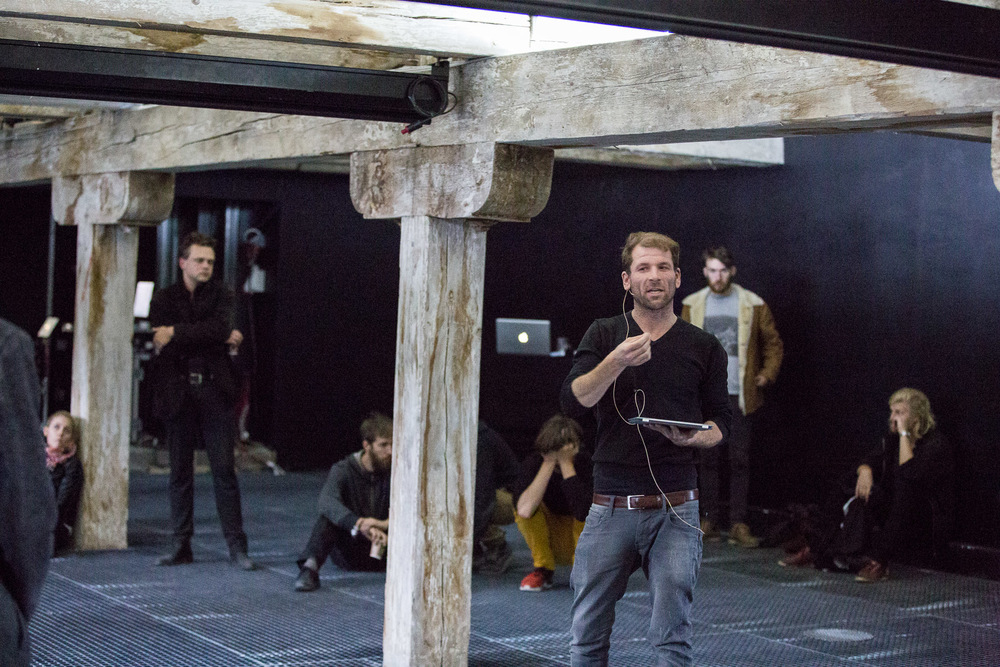 Rob Liethoff giving an interactive talk ‘Space Body Intelligence’ at the Spatial Sound Institute.
Rob Liethoff giving an interactive talk ‘Space Body Intelligence’ at the Spatial Sound Institute.Simultaneously, 4DSOUND and Robert Jan Liethoff continued developing their research into Space Body Intelligence, the ongoing dynamic process between the body, the surrounding space, and sound. The body is capable of feeling and hearing on such differentiated and sensitive levels that one could argue: the finer a listener tunes in with her or his body through direct physical awareness, the more they are able to steer and influence the sound in space as well. By working with refined spatial listening, are we able to gain a deeper sense of our intelligent physical self? Liethoff explores this question together with the audience in the form of a participative sound lecture.
 The 4DSOUND Max For Live patch, offering 200 parameters for spatial control
The 4DSOUND Max For Live patch, offering 200 parameters for spatial control4DSOUND has been constructed as an open-end spatialization format which means it allows to be controlled by custom-built and third-party software. Over the course of the years, we gathered a colourful and diverse collection of interfaces, ranging from responsive algorithms that link the spectral content of sound with its spatiality, devices that measure bio-physical and brain data to establish a direct connection between the body and the space, real-time position tracking of people moving in the space and custom-built instruments in software like Max/MSP, Supercollider and PureData to control 4DSOUND’s spatial dimensions.
 Frank Bretschneider performing in 4DSOUND at ADE 2014
Frank Bretschneider performing in 4DSOUND at ADE 2014In 2014, 4DSOUND curated the Sound Academy at Amsterdam Dance Event, the festival’s platform for inspiring new settings in music, technology and art. Among a program of masterclasses, workshops and performances with a variety of internationally respected artists, creators and thinkers, we premiered a show by musician, composer and visual artist Frank Bretschneider, also known as the co-founder of Berlin’s experimental imprint Raster-Noton. Establishing a responsivity between frequency, amplitude and spatiality of sound, Bretschneider explores the spatial continuum with minimalistic interwoven rhythmic structures in a most improvisatory way, subtly reminiscing the early days of experimental electronic music.
The work White Light Black Static by sound and video artist Marcel Wierckx, firstly presented as part of 4DSOUND’s residency at the Amsterdam club Warehouse Elementenstraat in March 2015, marks a different, more technically oriented approach as to what can be achieved with 4DSOUND as a coded environment.

White Light Black Static' performed at the Spatial Sound Institute for CAFe Budapest
A recent chapter in 4DSOUND’s interdisciplinary research is our partnership with New York-based company XTH. Their product, the Xth Sense, is a wearable bio-physical musical instrument turning inaudible sonic vibrations from the heart, blood flow and muscles into tangible sonic material. 4DSOUND commissioned the first batch of this new technology for use in our studio, to create new interactive works and conduct further research in the relationality between the outer space and the inner body.
'Exactly 10 years ago I came up with the idea of simultaneously visualizing and sonifying a recursive process using the fast fourier transform in real-time. That initial research led to the creation of my first fully immersive audiovisual compositions. For ‘White Light Black Static’ I’ve gone back to my core software routines from 2005 and rewritten them in the OpenGL shader language. I’ve also rewritten the audio synthesis engine so that it can be integrated seamlessly with 4DSOUND. Together this gives me extremely detailed control over the spatial positioning of both image and sound in real-time, allowing me to generate and manipulate complex audiovisual processes live.'
- Marcel Wierckx
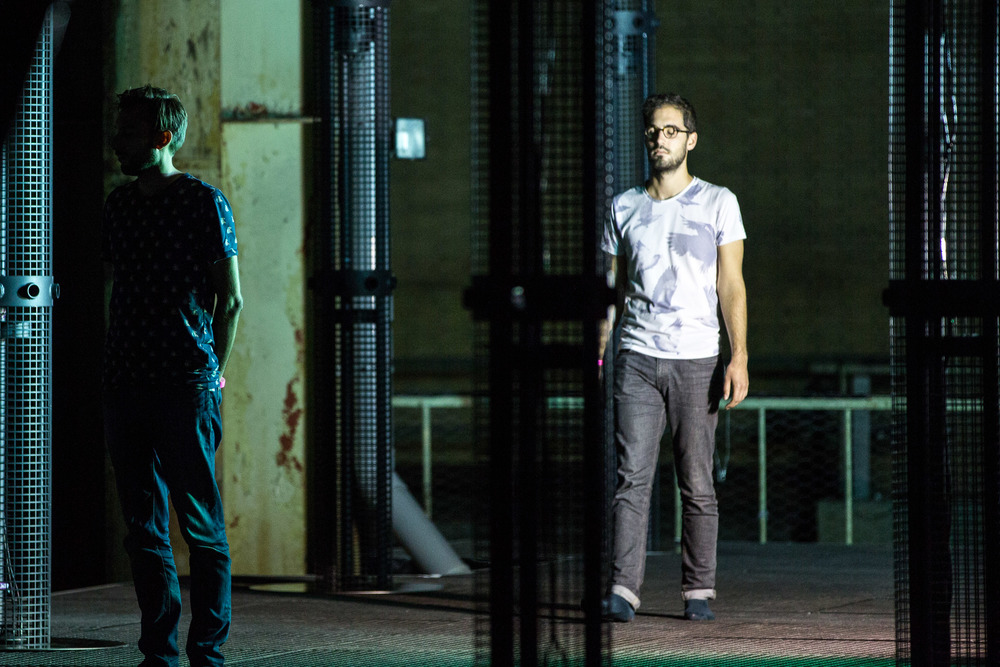 Guests experiencing Donnarumma's 0:Infinity at the Electriteitsfabriek, for TodaysArt.
Guests experiencing Donnarumma's 0:Infinity at the Electriteitsfabriek, for TodaysArt.XTH co-founder and performance artist, sound artist, musician and writer Marco Donnarummacreated the work 0:Infinity using the Xth Sense and 4DSOUND, premiered at TodaysArt Festival 2015 as part of the 4DSOUND: Circadian programme. The work is an unstable and reactive architecture of infrasound vibrations, audible sounds and high-powered lights brought to life by and through the visitors’ bodies. The architecture grows, morphs and falls apart through time, space and frequency derived from biophysical signals and movement data from the visitors’ bodies.
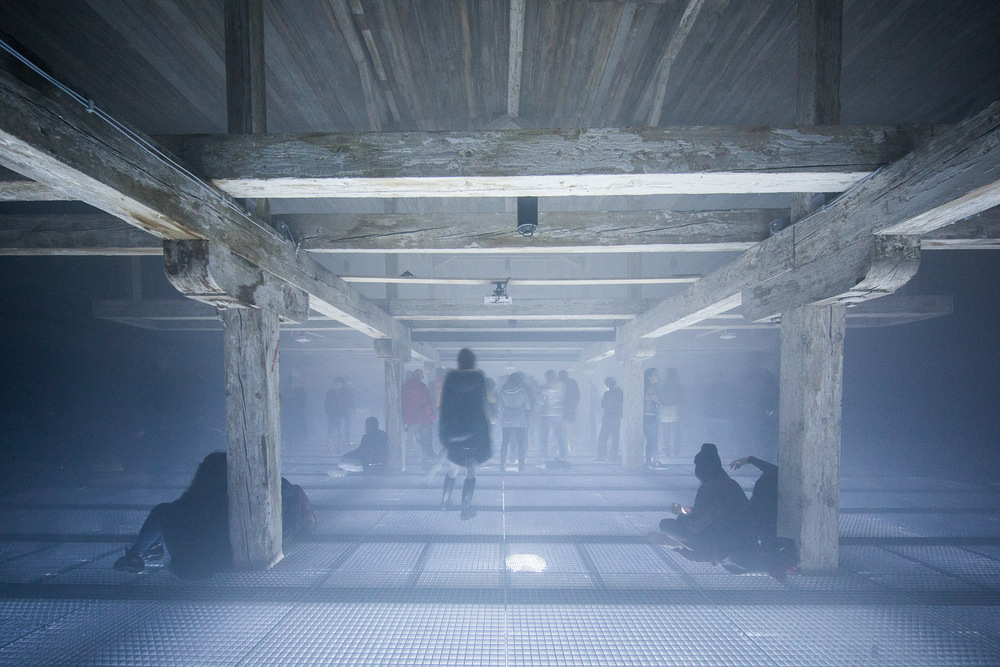 Visitors exploring the Spatial Sound Institute during the opening weekend Sound Exhibition.
Visitors exploring the Spatial Sound Institute during the opening weekend Sound Exhibition.The Sound Exhibition presented by CAFe Contemporary Art Festival Budapest was 4DSOUND’s first ever showing in Hungary, and premiered the new work Omnidirectional Synthesis by Budapest-based sound artist Gábor Lázár. Lázár’s aim in working with 4DSOUND is to create a close connection between pure sound synthesis and our perception of space. Working with one single instrument, his composition is characterised by a process of balancing between construction and deconstruction, consonance and dissonance, repetition and change, predictability and randomness, generating series of variations from these different processes. Though driven by generative techniques and precise automations, a clear emotional intensity and sensitivity for details emerges from his abstract approach to sound.

Gábor Lázár
At present, spatial sound is steadily gaining recognition as a new medium: a creative discipline that opens up ways of expression and communication with sound that were not possible before, allowing listeners to further their understanding of space and to develop more subtle, complex and intensive levels of awareness and interaction within space. Over the next decade we expect to see spatial sound developing into an established area of study with increasing influence on a range of scientific, socio-cultural and artistic areas.
These four years of emerging spatial sound practice have culminated in the opening of the Spatial Sound Institute, a permanent facility dedicated to this new discipline, a place for inspiration and creation, and a catalyst for emerging technological developments. The Spatial Sound Institute intends to broaden the international creative community to participate in thematic research, artistic creation with spatial sound much further, and will allow us to extend our work with specialists from diverse fields to conceptualize and perform projects, provide commentary, analysis and demonstrate insight into the implications of the medium within relevant fields in society.
Related:
 ‘Drifting in Void: Emerging Practices with Spatial Sound’ (2017) [PUBLICATIONS]
‘Drifting in Void: Emerging Practices with Spatial Sound’ (2017) [PUBLICATIONS] About the Spatial Sound Institute’ (2015) [PUBLICATIONS]
About the Spatial Sound Institute’ (2015) [PUBLICATIONS]